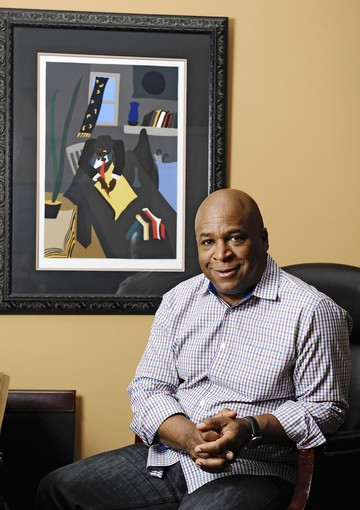
By Mary Carole McCauley, The Baltimore Sun
Vic Carter’s spacious Howard County home![]() is filled with more than 300 original paintings, small sculptures and figurines by black artists — and every single one has a story that the gregarious WJZ news anchor is eager to tell.
is filled with more than 300 original paintings, small sculptures and figurines by black artists — and every single one has a story that the gregarious WJZ news anchor is eager to tell.
This one, Carter said, pointing to an impressionistic painting of a young girl, the artist painted upside down — as the topsy-turvy signature attests. A small metal statue of a horse stood on his grandfather’s desk when Carter, now in his 50s, was a boy.
And a wall across from a staircase features a colorful canvas depicting Shango, the Yoruban deity of fire, lightning and thunder.
“I bought that painting in Havana in 1999, when I was covering the Orioles’ visit to Cuba,” Carter recalled.
“I’ve covered news stories on four different continents. I’ve covered natural disasters, and I’ve covered presidential campaigns. And everywhere I’ve gone, I try to bring at least one piece back.
“This artwork has become the story of my life.”
It’s not that the 4,500-square-foot, six-bedroom, five-bathroom home that Carter built in 1996 lacks charms of its own.
There’s the home’s spectacular setting; it backs up to a forested stretch of Patapsco State Park.
There’s the chipmunk who lives under the front steps, and there’s the bird of undetermined origin who “knocks on my door every day,” Carter said.
There’s the light-drenched, two-story great room, the gleaming oak floors throughout the home, and the expansive deck, painted a light gray, that leads off the master bedroom![]() .
.
Carter lives in the home with his wife and daughter, and the family has chosen traditional mahogany furnishings. The flowing feeling of the open floor plan is reinforced by a unified color palette of furniture and draperies upholstered in hunter green and burgundy, which sets off walls painted the color of late afternoon sunlight.
“We wanted to keep the setting calm, neutral, and in touch with nature,” he said. “We want people to feel comfortable![]() here, as though they could kick off their shoes when they walk through the front door.”
here, as though they could kick off their shoes when they walk through the front door.”
A favorite retreat is the kitchen, which is soon to undergo an extensive remodeling, in part to accommodate the left-handed chef.
Carter is an inventive and imaginative cook; one of his “go-to” dishes for drop-in guests is limoncello shrimp, a concoction he dreamed up from ingredients he had on hand: lemons, Old Bay, parsley, garlic and angel hair pasta.
The remodeling will retain the existing cherry cabinets. But the appliances will be updated, the central island will be extended to include a recycling area, and a ceramic floor will be installed. In addition, the kitchen will be unified thematically with the rest of the home by exchanging the existing Formica countertops for granite, a natural material.
“Vic knows what he wants,” said Carter’s contractor, Joe Basta, who’s in charge of remodeling for the Hampstead-based Brothers Services Co.
“He’s very neat and clean and precise, and he’s been very involved in the design![]() process. He has a good eye and he has good taste, but they aren’t necessarily extravagant tastes. He’s a very down-to-earth guy,” Basta said. “Every time we come over, he asks us as many questions about our lives as we ask him about his, and that’s refreshing.”
process. He has a good eye and he has good taste, but they aren’t necessarily extravagant tastes. He’s a very down-to-earth guy,” Basta said. “Every time we come over, he asks us as many questions about our lives as we ask him about his, and that’s refreshing.”
But the home’s most striking — and personal — design element unquestionably is the art. The collection of works created primarily by black artists reflects a man confident about his own aesthetic judgments.
Some pieces are museum quality. For instance, a lithograph by Jacob Lawrence sits above the desk in Carter’s office. In it, the abolitionist leader Frederick Douglass is bent over his desk — perhaps, Carter speculates, laying out an edition of “The North Star,” the anti-slavery paper he founded.
Another lithograph, “Dream of Exile” by the master collagist Romare Bearden, hangs in a hallway between the great room and the kitchen. The work is an intricate, fanciful landscape in which animal, bird and fish faces peek out from behind the cover of trees, grass and waves.
Another piece is by a familiar figure in an unfamiliar context. A canvas painted in strong indigos and pure whites was created by the actor Billy Dee Williams. The piece, “Choir,” shows the voices of a church’s singers ascending to the heavens in the form of doves.
“Billy Dee Williams originally studied to be an artist,” Carter said. “He began acting to find a way to pay for his painting tools.”
But other works were found in open-air markets and cost the anchorman just a few dollars. The collection also includes a significant representation of local artists, including Tom Miller and Paula Whaley.
“A lot of times, I’m hanging the artist even more than the art,” Carter said. “If I get interested enough in the person making the artwork, he could sell me a case of chipped beef and I’d put it on the wall.”
